“Are you a good reader?” The question came up one day while chatting with colleagues. We had been reflecting on the power of high-effect size instructional strategies. One colleague mentioned, “I’m not a good reader. I don’t do any of the reciprocal teaching strategies when I read text. It takes me a long time to process text.” This perplexed me as much as it had when I taught third graders.
While I encouraged reading with my students, I was unsure of reading strategies. Students came to me able to read or not. Since then, I’ve had a chance to grow in my awareness. Let’s take a quick peek at reading and learn how you can help improve reading and comprehension skills in your classroom.
The Value of Phonics
“Every experience, no matter how bad, gives some lesson.” I learned that early on as I flunked second grade reading and language arts. It was the only time I doubted the value of learning two languages at the same time. Thanks to my mother’s intense lobbying, I found myself studying phonics (d=0.60) all summer. If I survived phonics boot camp, I could graduate to third grade. I learned how to read, all about antonyms and homonyms, morphology, and more. Then, I did my best to forget the time spent away from the beach and play. My phonics summer of misery slipped into oblivion.
Phonics instruction enjoys an effect size of 0.60. The VisibleLearning MetaX database defines it in the following way.
“A form of instruction that stresses the acquisition of letter-sound correspondences. The focus is on reading and spelling. It involves teaching children the sounds made by individual letters or letter groups. Children learn how to merge separate sounds together to make it one word. For example, blending the sounds k, a, t makes CAT.”
After my summer of phonics, reading came easier and I started to enjoy it. Many children today, however, remain stuck, unable to enjoy comprehension for pleasure. They, like my colleague, see reading as a laborious journey, fraught with difficulty. One way to solve this problem is to focus on what good readers do and then support learners.
What Good Readers Do
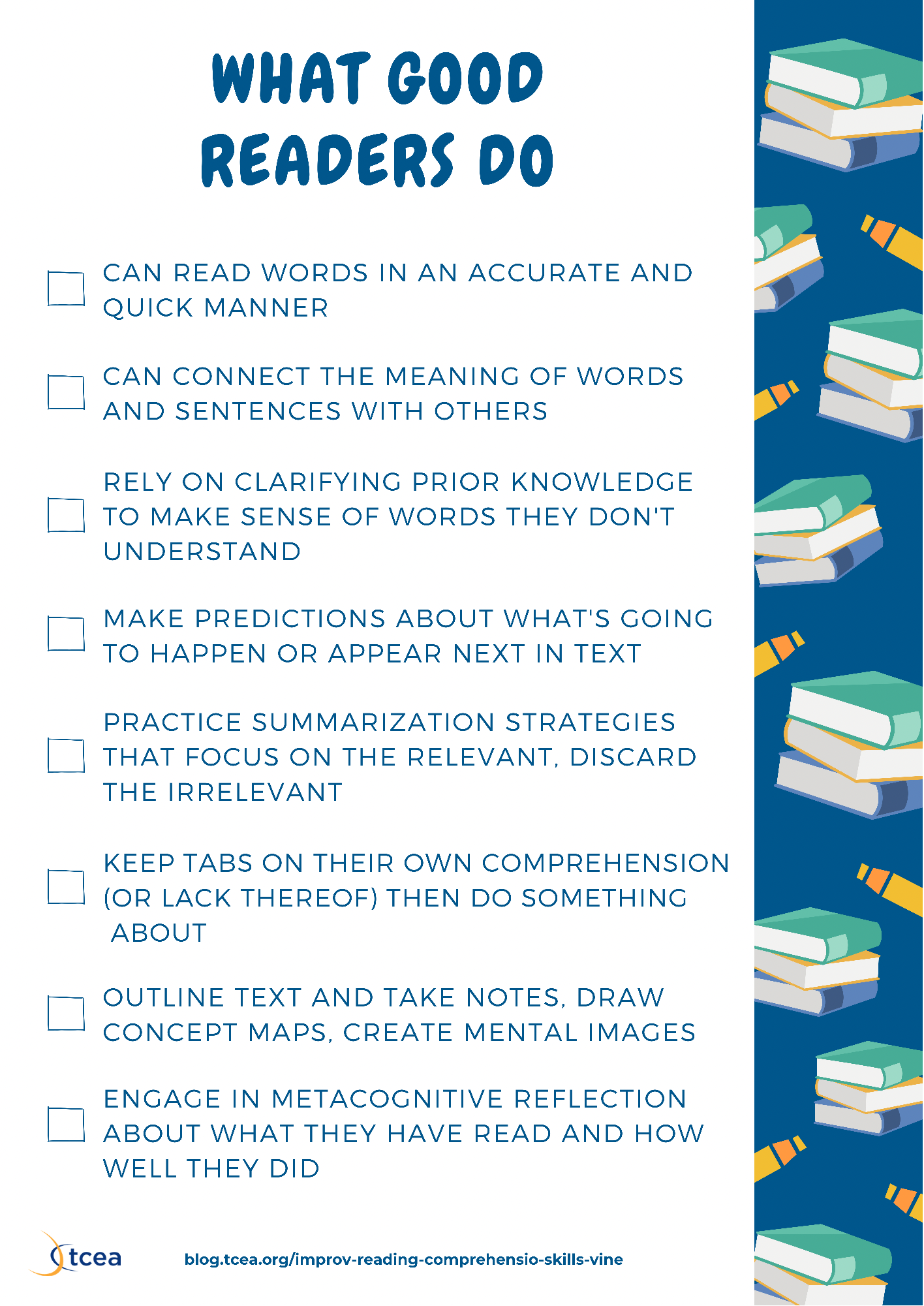
Here is a list of eight actions that good readers take during reading. How many items can you check off? Good readers:
- Can read words in an accurate and quick manner
- Can connect the meaning of words and sentences with others
- Rely on clarifying prior knowledge to make sense of words they don’t understand
- Make predictions about what’s going to happen or appear next in text
- Practice summarization strategies that focus on the relevant, discard the irrelevant
- Keep tabs on their own comprehension (or lack thereof) then do something about it
- Outline text and take notes, draw concept maps, create mental images
- Engage in metacognitive reflection about what they have read and how well they did
More actions appear in this article, What Research Tells Us About Reading Comprehension. The eight actions above remind me of reciprocal teaching (d=0.74). That makes this high-effect size, deep learning reading approach powerful and suggest other high-effect size strategies. Those include repeated reading programs (d=0.75) and vocabulary programs (d=0.63). The latter provides a suite of strategies to aid comprehension. Unlike reciprocal teaching, these two strategies focus on surface learning. Vocabulary programs work well with younger learners given its focus on morphology.
Let’s review the list again with an eye towards strategies. If you want a complete list of learning strategies, check out Visible Learning for Literacy.
Aligning Actions to Learning Strategies
Let’s go through that list again and see if we can group the actions under strategies that work. I labeled learning intentions in this way:
- (S) = Surface Learning
- (D) = Deep Learning
- (T) = Transfer Learning
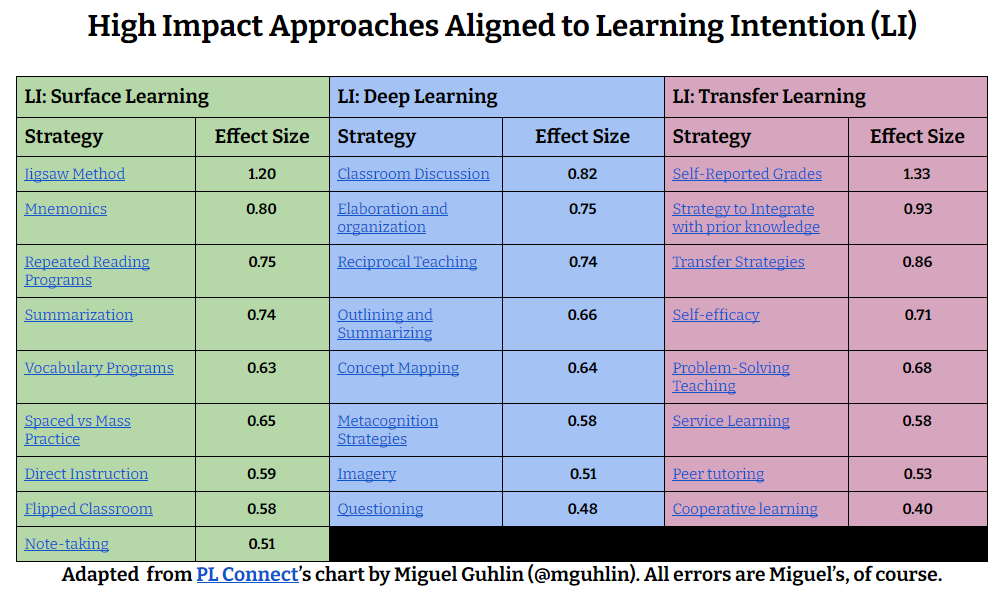
View | Make your own copy via Google Docs
Ready? Let’s go.
- Repeated Reading Programs (d=0.75) (S)
- Can read words in an accurate and quick manner
- Vocabulary Programs (d=0.63) (S)
- Can connect the meaning of words and sentences
- Note-Taking (d=0.51), Concept Mapping (d=0.64) (D)
- Outline text and take notes, draw concept maps, create mental images
- Reciprocal Teaching (d=0.74) (D)
- Rely on clarifying prior knowledge to make sense of words they don’t understand
- Make predictions about what’s going to happen or appear next in text
- Practice summarization strategies that focus on the relevant, discard the irrelevant
- Keep tabs on their own comprehension (or lack thereof) then do something about
- Metacognition Strategies (d=0.58) (D)
- Engage in metacognitive reflection about what they have read and how well they did
- Strategy to integrate with prior knowledge (d=0.93)
With all these wonderful strategies, how might you introduce students to using them? One approach involves offering students K-12 reading passages. Find passages based on specific levels, grades, and learning styles. How do you do that online in a hybrid classroom?
Introducing Reading Vine
Reading Vine offers free resources to help improve reading and comprehension skills that include fiction, nonfiction, poetry, essays, and stories. What’s more, questions and answers, worksheets, and activities are also available. A wide variety of educators and parents use Reading Vine to provide personalized reading experiences. There is a wide range of content, of which only a small excerpt appears below:

Always keen to learn a bit more about Hispanic heritage in Texas, I took a quick peek at this collection. It includes a brief overview (shown below), as well as several passages.
Overview
Over 57 million Americans – almost 18% of the population – claim Hispanic ancestry. This reading set celebrates the rich and vibrant heritage of this group. There are fiction and nonfiction passages, and one is certain to be of interest to your student.
The three passages in this collection include a clip of music, nonfiction, and fiction:
- Cielito Lindo (song available in Spanish and English)
- Primary Source: Opening of the Panama Canal
- The Secret Box by Elizabeth Trach
Alas, Cielito Lindo doesn’t include any actual audio. You can listen and read the lyrics in Spanish online:
Each text comes with an easy to create PDF and reading comprehension questions. An answer key is also included.
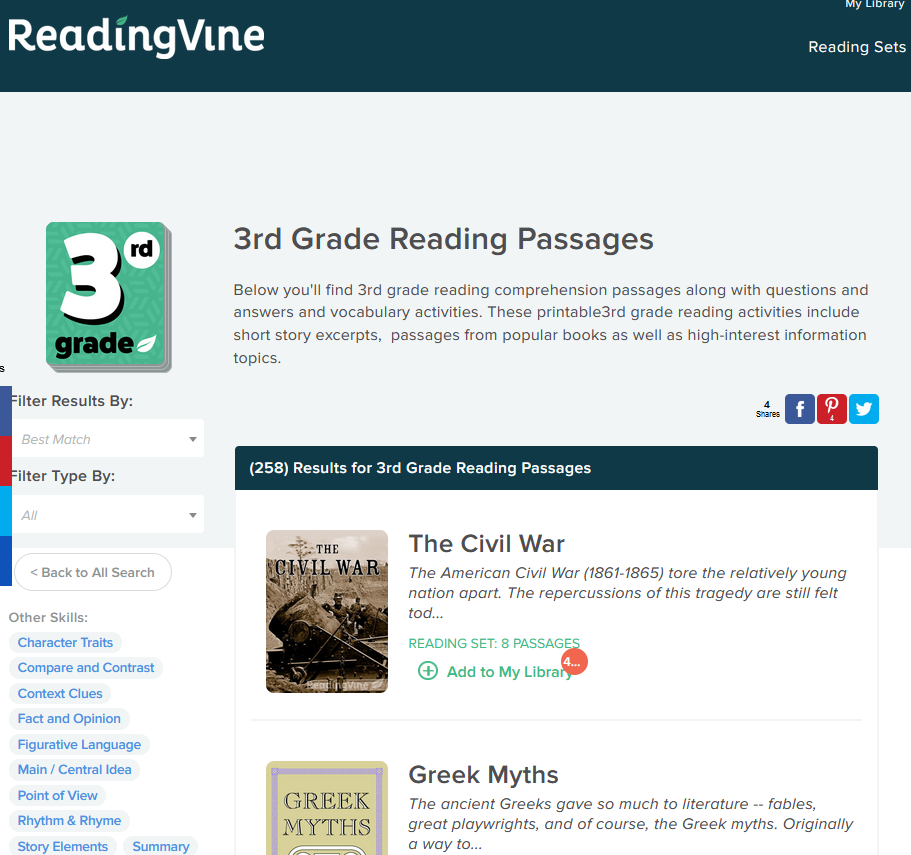
Add collections of content, or reading sets, to your “My Library.” You can see a list of a few of my favorites in the screenshot below:
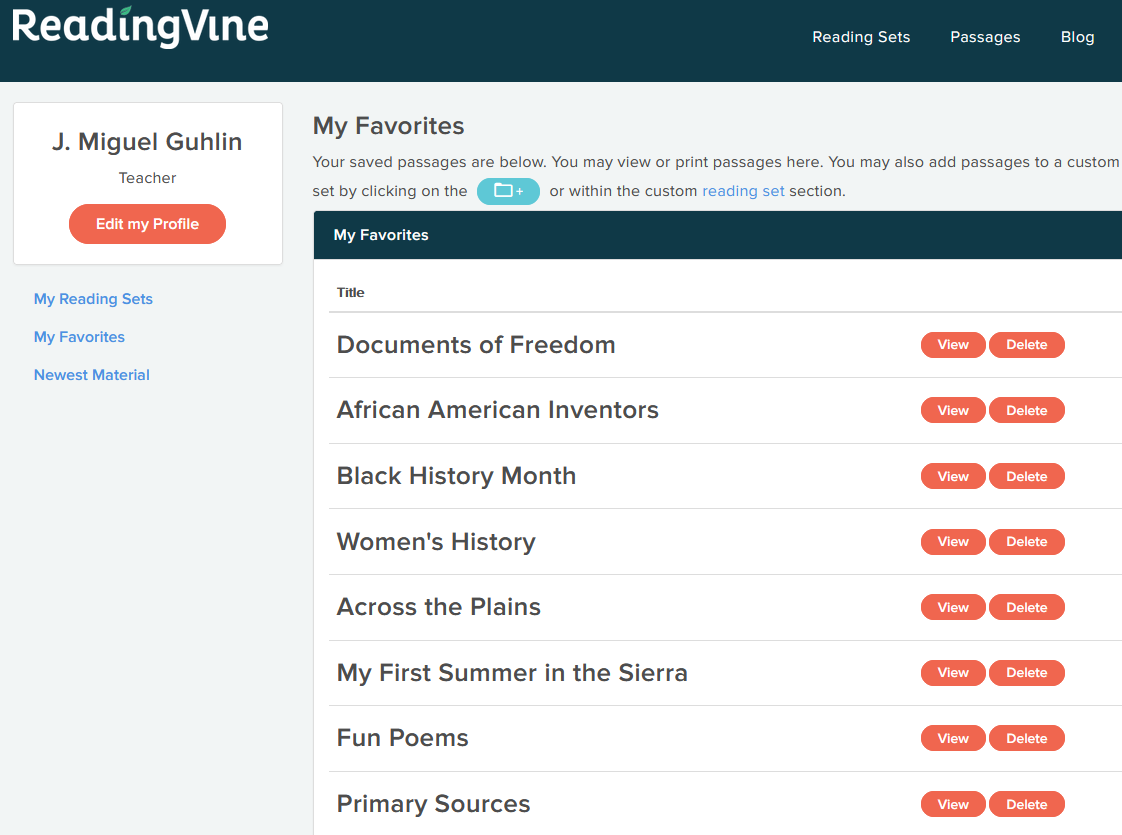
Getting Started with Reading Vine
To get started with Reading Vine, you can set up an account with either Google or Office 365. Or you can use an email address and come up with a password. Once you have your account or profile set up, you can explore a variety of reading sets.
Once your account setup and reading sets are ready to go, you can create a PDF with favorite passages. These PDFs come with activities as well. This makes them easy to share with students via your learning management system.
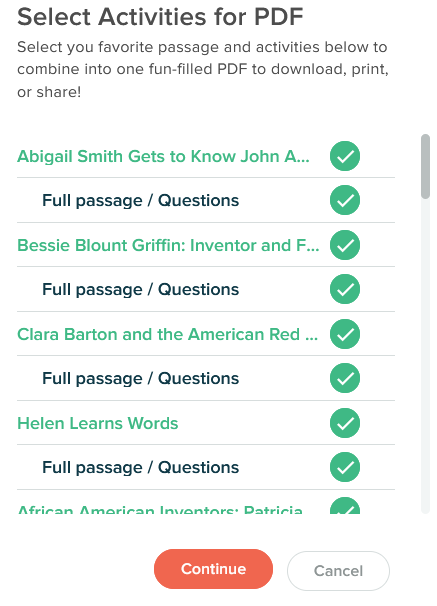
Here’s what the PDF content looks like, featuring Dr. Patricia Bath in the Women’s History set:
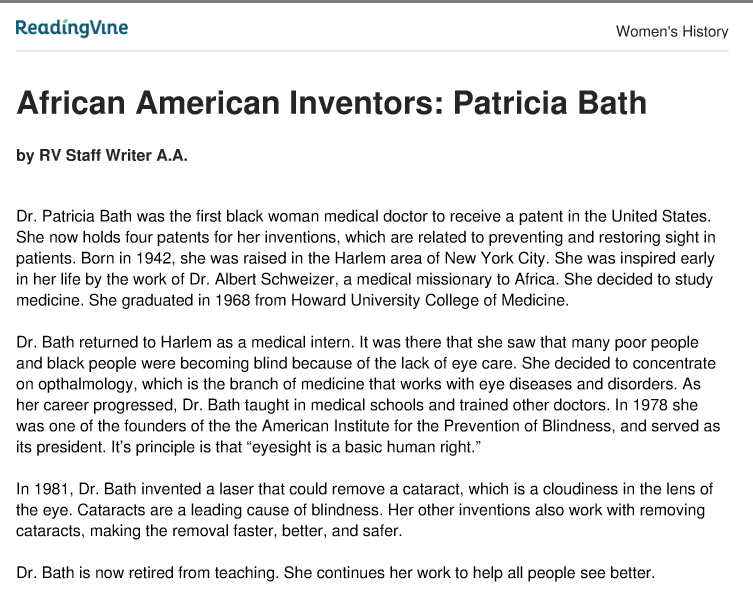
The selection comes with five questions, including:
- Where did Dr. Bath grow up?
- Who inspired Dr. Bath to study medicine?
- What is ophthalmology?
- How many patents does Dr. Bath have?
- What is a cataract?
These are simple questions and can be used as a starting point. Why not employ a powerful strategy like the jigsaw method to dig into the content?
Matching Strategies to Reading Sets
Now that you’ve seen some of what Reading Vine offers, consider the strategies. There are several strategies students could use as they work through the text. You could rely on vocabulary programs to dig into the meaning of words. One vocabulary programs approach includes using concept sorts. You might have students put together a concept sort using a visual organizer like Circly.
Another might include doing word analysis with a Frayer Model graphic organizer. To focus on comprehension, students could engage in note taking or reciprocal teaching. Reading Vine offers some excellent content you can use to get started.
Feature Image Source
Screenshot by author.



1 comment
Great stuff! Love Hattie!